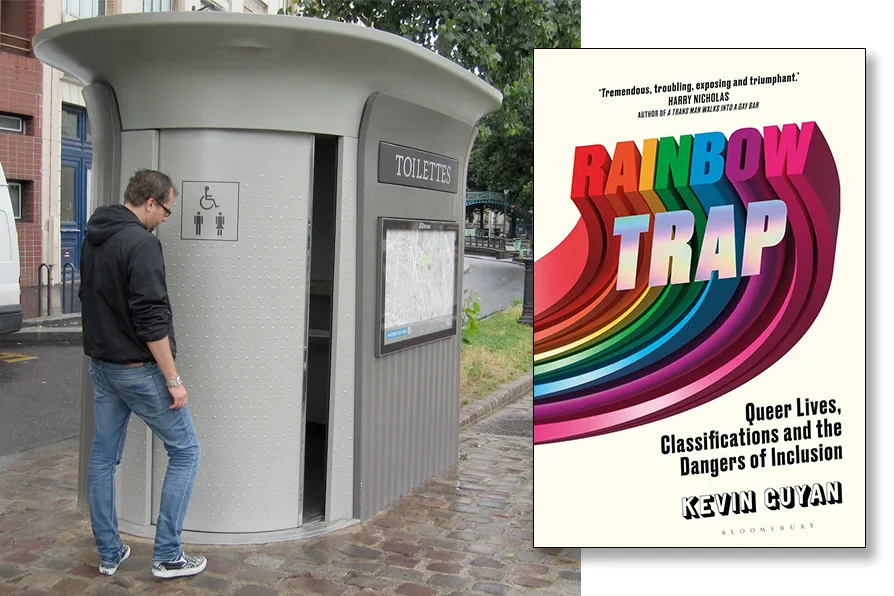JOE GILL speaks to the Palestinian students in Gaza whose testimony is collected in a remarkable anthology
CAILEAN MCBRIDE welcomes a refreshing and timely study of the way officialdom creates structures that exclude LGBT+ rights and humanity

 Toilet block at a park in Brisbane, Australia: the toilet block has two cubicles, both marked as unisex and accessible toilets, and a sink outside of the cubicles for handwashing. / Pic: EMsmile/CC
Toilet block at a park in Brisbane, Australia: the toilet block has two cubicles, both marked as unisex and accessible toilets, and a sink outside of the cubicles for handwashing. / Pic: EMsmile/CC
The Rainbow Trap: Queer Lives, Classifications and the Dangers of Inclusion
Kevin Guyan, Bloomsbury, £20
PUBLICATION can often be something of a long game. From commission through writing to hitting the bookstands, months and sometimes even years can have elapsed. If you’re writing something even vaguely related to current events this can be bad news, especially in these days of wildly accelerated news cycles, because its topicality could have all but evaporated.
The opposite is also true, of course, and a book can be given a boost by an unexpected turn of events. And that, to an extent, is what has happened here. Given the ongoing – and often heated – public discourse on sex and gender, there was never any question of there not being an audience for the Rainbow Trap, but with its publication coming not long after the UK Supreme Court’s controversial ruling on the definition of “woman” under the Equality Act, it has suddenly graduated from a compelling read to an essential one.
I must admit that I did initially approach the book with some trepidation. At first glance, it seemed to me it could have been yet another right-wing rant on the “folly” of DEI and wokeism but I needn’t have worried. The book is, in fact, a nuanced and detailed examination of the efficacy of equality metrics on job application forms and other mechanisms of officialdom.
Guyan, far from complaining that such mechanisms have “gone too far,” argues that they perhaps haven’t gone nearly far enough to effect any meaningful inclusion of the LGBT+ community and are instead designed more for the comfort of the “cis-het” population by reframing the complexity and variety of LGBT+ experience in a way that is comfortable and palatable for those institutions but less so for those directly affected.
To do this, the book focuses greatly on statistical data, which may sound dry but is actually pretty fascinating and gives the work a refreshing heft, but which will, I suspect, prove a useful bulwark against the usual onslaught of anecdote and skewed misinterpretation that might be brought to bear against it.
Each of the six chapters focuses on a different social institution, ranging from the police and the reporting of hate crimes to the often exclusionary nature of dating apps, to representation in the media and queer workers in business. Some of these may sound more trivial than others but all provide some useful insight to the tension between lived queer experience and how it is often (mis)translated by rigid, cis-hetero structures.
Perhaps the most instructive chapter, however, is the one on Borders in which Guyan lays bare the many hoops that LGBT asylum-seekers and refugees have to go through in order to satisfy Home Office officials that they are in fact “gay enough” and, moreover, in a way that they comfortably recognise. Thus, asylum-seekers will often eschew the authentic narratives in favour of telling officialdom what they want to hear.
It’s in the course of this discussion in particular that Guyan lays bare that what’s actually at play here is a new iteration of Achille Mbembe’s necropolitics – the idea that the state and/or its institutions are now indulging in biopolitical calculations on who deserves to live and who to die.
This is, of course, at its most stark within the context of the immigration system but Guyan also goes on to explore what that means within the ostensibly more innocuous category of health and fitness where bodies, both cis and trans, are put increasingly under the microscope and evaluated as who truly “counts” as human and therefore more deserving of rights.
Issues such as these obviously have an extremely active currency in the wake of the recent Supreme Court ruling and the subsequent EHRC “guidance,” not to mention the torrent of bathroom bans that have followed in their wake.
Guyan’s conclusion that the solution might be to smash this machinery of evaluation altogether and to “refuse what is being refused” will perhaps be of significant appeal to the “box-breakers” who increasingly find that the now-disintegrating narratives of inclusion were, in any case, designed as a means of control rather than emancipation.

STEVE ANDREW enjoys an account of the many communities that flourished independently of and in resistance to the empires of old













